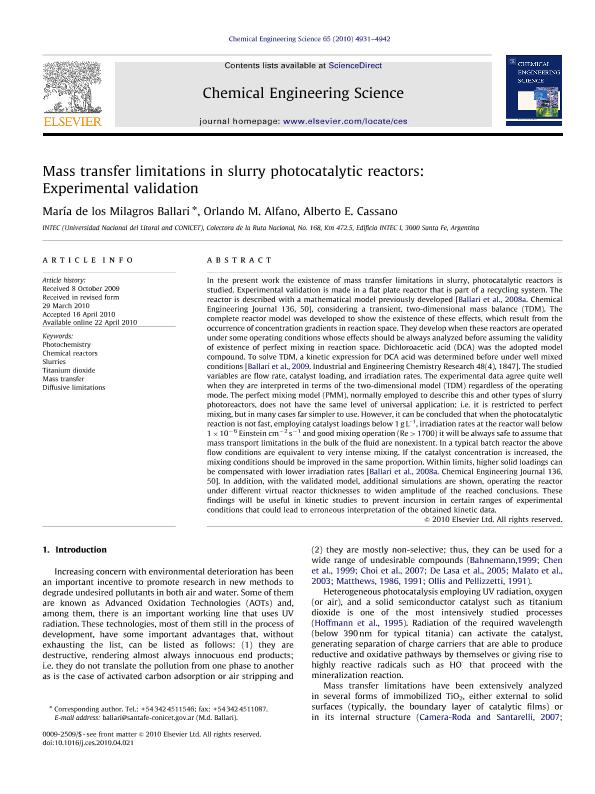Artículo
Mass Transfer Limitations in Slurry Photocatalytic Reactors: Experimental Validation
Fecha de publicación:
04/2010
Editorial:
Elsevier
Revista:
Chemical Engineering Science
ISSN:
0009-2509
Idioma:
Inglés
Tipo de recurso:
Artículo publicado
Clasificación temática:
Resumen
In the present work the existente of mass transfer limitations in slurry, photocatalytic reactors is studied. Experimental validation is made in a flat plate reactor that is part of a recycling system. The reactor is described with a mathematical model previously developed [Ballari et al., 2008a. Chemical Engineering Journal 136, 50], considering a transient, two-dimensional mass balance (TDM). The complete reactor model was developed to show the existence of these effects, which result from the occurrence of concentration gradients in reaction space. They develop when these reactors are operated under some operating conditions whose effects should be always analyzed before assuming the validity of existence of perfect mixing in reaction space. Dichloroacetic acid (DCA) was the adopted model compound. To solve TDM, a kinetic expression for DCA acid was determined before under well mixed conditions [Ballari et al., 2009. Industrial and Engineering Chemistry Research 48(4), 1847]. The studied variables are flow rate, catalyst loading, and irradiation rates. The experimental data agree quite well when they are interpreted in terms of the two-dimensional model (TDM) regardless of the operating mode. The perfect mixing model (PMM), normally employed to describe this and other types of slurry photoreactors, does not have the same level of universal application; i.e. it is restricted to perfect mixing, but in many cases far simpler to use. However, it can be concluded that when the photocatalytic reaction is not fast, employing catalyst loadings below 1gL–1, irradiation rates at the reactor wall below 1x10x-6 Einstein cm-2 s-1 and good mixing operation (Re41700) it will be always safe to assume that mass transport limitations in the bulk of the fluid are non existent. In a typical batch reactor the above flow conditions are equivalent to very intense mixing. If the catalyst concentration is in creased, the mixing conditions should be improved in the same proportion. Within limits, higher solid loadings can be compensated with lower irradiation rates[Ballarietal.,2008a. Chemical Engineering Journal 136, 50]. In addition, with the validated model, additional simulations are shown, operating the reactor under different virtual reactor thicknesses to widen amplitude of the reached conclusions. These findings Hill be useful in kinetic studies to prevent incursion in certain ranges of experimental conditions that could lead to erroneous interpretation of the obtained kinetic data.
Palabras clave:
Photochemistry
,
Chemical Reactors
,
Slurries
,
Titanium Dioxide
Archivos asociados
Licencia
Identificadores
Colecciones
Articulos(INTEC)
Articulos de INST.DE DES.TECNOL.PARA LA IND.QUIMICA (I)
Articulos de INST.DE DES.TECNOL.PARA LA IND.QUIMICA (I)
Citación
Ballari, Maria de Los Milagros; Alfano, Orlando Mario; Cassano, Alberto Enrique; Mass Transfer Limitations in Slurry Photocatalytic Reactors: Experimental Validation; Elsevier; Chemical Engineering Science; 65; 17; 4-2010; 4931-4942
Compartir




